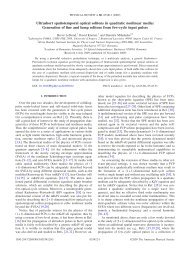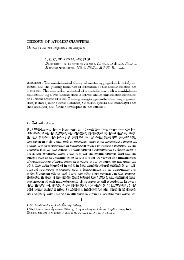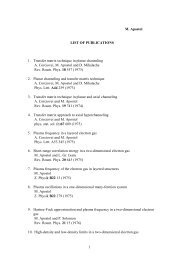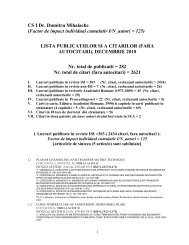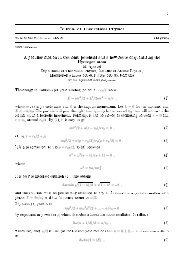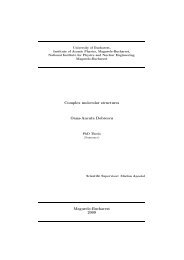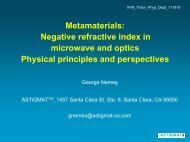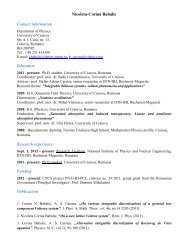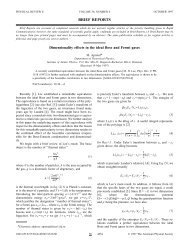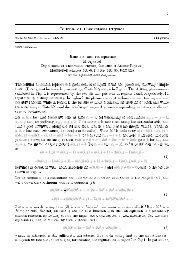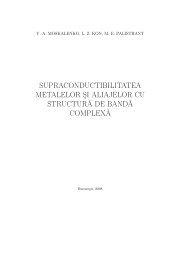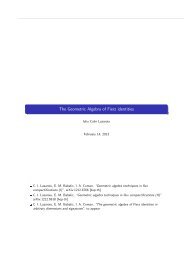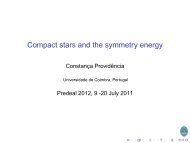Electron-phonon coupling in one dimension
Electron-phonon coupling in one dimension
Electron-phonon coupling in one dimension
You also want an ePaper? Increase the reach of your titles
YUMPU automatically turns print PDFs into web optimized ePapers that Google loves.
J. Phys. C: Solid State Phys., 15 (1982) 3319-3331. Pr<strong>in</strong>ted <strong>in</strong> Great Brita<strong>in</strong><br />
<strong>Electron</strong>-<strong>phonon</strong> <strong>coupl<strong>in</strong>g</strong> <strong>in</strong> <strong>one</strong> <strong>dimension</strong><br />
M Apostolt and I BaldeaS<br />
t Institute for Physics and Nuclear Eng<strong>in</strong>eer<strong>in</strong>g, Magurele, Bucharest, MG-6, Romania<br />
$ Central Institute of Physics, Astronomy and Space Research Centre, Magurele,<br />
Bucharest, MG-6, R7600, Romania<br />
Received 17 August 1981, <strong>in</strong> f<strong>in</strong>al form 2 December 1981<br />
Abstract. The Ward identity is derived for the electron-<strong>phonon</strong> <strong>coupl<strong>in</strong>g</strong> <strong>in</strong> <strong>one</strong> <strong>dimension</strong><br />
and the spectrum of elementary excitations is calculated by assum<strong>in</strong>g that the Fermi distribution<br />
is not strongly distorted by the <strong>in</strong>teraction. The electron-<strong>phonon</strong> vertex is renormalised<br />
<strong>in</strong> the case of the forward scatter<strong>in</strong>g and Migdal’s theorem is discussed. A model is<br />
proposed for the giant Kohn anomaly. The dip <strong>in</strong> the <strong>phonon</strong> spectrum is obta<strong>in</strong>ed and<br />
compared with the experimental data for KCP.<br />
1. Introduction<br />
Recently there has been considerable <strong>in</strong>terest <strong>in</strong> the electron-<strong>phonon</strong> <strong>coupl<strong>in</strong>g</strong> <strong>in</strong> the<br />
<strong>one</strong>-<strong>dimension</strong>al many-electron systems, especially <strong>in</strong> connection with the <strong>in</strong>stabilities<br />
of the nearly <strong>one</strong>-<strong>dimension</strong>al conductors toward both dynamic and structural changes<br />
(for a recent review see, for example, Devreese et a1 1979).<br />
The cha<strong>in</strong>-like structure of the lattice of these materials conf<strong>in</strong>es the motion of the<br />
electrons to <strong>one</strong> direction <strong>in</strong> space and this permits the l<strong>in</strong>earisation of the momentum<br />
dependence of the free-electron levels with<strong>in</strong> two f<strong>in</strong>ite regions centred around kkF, kF<br />
be<strong>in</strong>g the Fermi momentum. The l<strong>in</strong>ear spectrum of the s<strong>in</strong>gle-electron states near<br />
*kF produces high divergencies <strong>in</strong> the relevant quantities (logarithmic s<strong>in</strong>gularities) and<br />
this results <strong>in</strong> an unusual behaviour of the <strong>one</strong>-<strong>dimension</strong>al conductors. Most of the<br />
phenomena generally occurr<strong>in</strong>g for all condensed matter systems are strongly enhanced<br />
<strong>in</strong> this materials. Therefore, it is important to see to what extent the above-menti<strong>one</strong>d<br />
s<strong>in</strong>gularities will be reflected <strong>in</strong> the physical behaviour of the systems. Particularly<br />
<strong>in</strong>terest<strong>in</strong>g is the giant Kohn anomaly observed <strong>in</strong> the <strong>phonon</strong> spectrum near 2kF and<br />
the associated soften<strong>in</strong>g of the <strong>phonon</strong> modes. This strong distortion of the <strong>phonon</strong><br />
spectrum <strong>in</strong> <strong>one</strong> <strong>dimension</strong> has been <strong>in</strong>vestigated by Afanas’ev and Kagan (1963). It<br />
was shown that this effect orig<strong>in</strong>ates <strong>in</strong> a sharp <strong>in</strong>crease <strong>in</strong> the number of low-energy<br />
states available for the electron-hole excitation accompanied by the absorption or<br />
emission of <strong>phonon</strong>s with wavevectors near 2kF.<br />
The aim of the present paper is to <strong>in</strong>vestigate the electron-<strong>phonon</strong> <strong>in</strong>teraction <strong>in</strong> the<br />
<strong>one</strong>-<strong>dimension</strong>al many-electron system with<strong>in</strong> the perturbation theoretical approach.<br />
An electron gas model is proposed hav<strong>in</strong>g explicitly <strong>in</strong>troduced a band-width cut-off.<br />
As the low excited states of the system consist of electron-hole pairs <strong>in</strong> the neighbourhood<br />
of the + k po<strong>in</strong>ts ~ we restrict ourselves to these s<strong>in</strong>gle-electron states only. Their<br />
0022-3719/82/153319 + 13 $01.50 @ 1982 The Institute of Physics 3319
3320 M Apostol and I Baldea<br />
wavevectors p run with<strong>in</strong> the range +kF - k, < p < ?kF + k,, where k, is the bandwidth<br />
cut-off, much smaller than kF. The energy levels of the electron states can be<br />
l<strong>in</strong>earised as follows: eP = p + UF( lp I - kF), where pis the Fermi level and UF is the Fermi<br />
velocity. Two types of electron-<strong>phonon</strong> <strong>in</strong>teraction processes may take place <strong>in</strong> this<br />
model. The first is the forward scatter<strong>in</strong>g process, that excites an electron-hole pair near<br />
+kF by creat<strong>in</strong>g or absorb<strong>in</strong>g a virtual <strong>phonon</strong> of small wavevector. The second is the<br />
backscatter<strong>in</strong>g process <strong>in</strong> which the electron-hole pair excited across the Fermi sea is<br />
accompanied by the emission or absorption of a <strong>phonon</strong> with wavevector near 2kF.<br />
Our approach relies upon the Ward identity which connects the electron-<strong>phonon</strong><br />
vertex to the electron Green function. This identity is a direct consequence of the l<strong>in</strong>ear<br />
electron spectrum and of the conservation of the number of electrons near +kF. The<br />
Ward identity is derived here by means of the equation-of-motion method <strong>in</strong> a manner<br />
analogous to that used for the electron-electron <strong>in</strong>teraction (Apostol 1981a). For the<br />
forward scatter<strong>in</strong>g process this is an exact result, extensively used <strong>in</strong> study<strong>in</strong>g the<br />
electron-electron <strong>in</strong>teraction <strong>in</strong> <strong>one</strong>-<strong>dimension</strong>al systems (Dzialosh<strong>in</strong>sky and Lark<strong>in</strong><br />
1973, Everts and Schulz 1974). The Ward identity is generalised here to the backscatter<strong>in</strong>g<br />
process <strong>in</strong> the limit of weak <strong>coupl<strong>in</strong>g</strong>, that is when the ground state is not too<br />
strongly distorted by <strong>in</strong>teraction. The Ward identity is particularly suitable for treat<strong>in</strong>g<br />
our model as it allows us to control at every step the conf<strong>in</strong>ement of the electron<br />
wavevectors to the two regions around +kF. Moreover, it can be used to get a simple,<br />
physical mean<strong>in</strong>g of the approximations made <strong>in</strong> work<strong>in</strong>g out the complete set of <strong>in</strong>tegral<br />
equations of the perturbation theory.<br />
The polarisation and the normal modes are calculated both for the forward and<br />
backward scatter<strong>in</strong>g processes assum<strong>in</strong>g that the <strong>in</strong>teraction does not distort appreciably<br />
the Fermi sea. The Ward identity is used to renormalise the electron-<strong>phonon</strong> vertex<br />
and to check the validity of Migdal's theorem <strong>in</strong> the case of the forward scatter<strong>in</strong>g. It is<br />
shown that, unlike the three-<strong>dimension</strong>al case, the electron dress<strong>in</strong>g is O(mlM), m and<br />
M be<strong>in</strong>g the electronic and ionic mass, respectively. The electrons may be considered to<br />
a good approximation as undressed <strong>in</strong> comparison with the <strong>phonon</strong>s. Particular attention<br />
is paid to the <strong>phonon</strong> modes of wavevectors near 2k~.<br />
The giant dip of the Kohn anomaly<br />
is obta<strong>in</strong>ed with<strong>in</strong> our model and compared with the experimental data for KCP. It is<br />
shown that the band-width cut-off k, plays an essential role <strong>in</strong> describ<strong>in</strong>g this strong<br />
distortion of the <strong>phonon</strong> spectrum. We should remark that similar calculations have<br />
been attempted by Horovitz et a1 (1974). As they were <strong>in</strong>terested only <strong>in</strong> the drastic<br />
effects, they used an unrealistic model <strong>in</strong> which the cut-off parameter does not appear.<br />
This is why their results cannot be compared with the experiments. Our calculations,<br />
made for the case of KCP, are <strong>in</strong> agreement with the experimental data.<br />
The paper is organised as follows. The Ward identity is derived <strong>in</strong> 9 2. The forward<br />
scatter<strong>in</strong>g process and the Migdal theorem are discussed <strong>in</strong> 0 3. In 9 4 the backscatter<strong>in</strong>g<br />
process is analysed and the dip is obta<strong>in</strong>ed <strong>in</strong> the <strong>phonon</strong> spectrum of KCP. The<br />
conclusions are given <strong>in</strong> 0 5.<br />
2. Ward identity for the electron-<strong>phonon</strong> <strong>coupl<strong>in</strong>g</strong> <strong>in</strong> <strong>one</strong> <strong>dimension</strong><br />
Let us assume a <strong>one</strong>-<strong>dimension</strong>al electron-<strong>phonon</strong> system described by the Frohlich<br />
type Hamiltonian<br />
H =<br />
E~C~C,, + m46,'6, + g (w#2) "76, + 6 T4) cP++4cP, (1)<br />
P 4 P.4
<strong>Electron</strong>-<strong>phonon</strong> <strong>coupl<strong>in</strong>g</strong> <strong>in</strong> <strong>one</strong> <strong>dimension</strong> 3321<br />
where cp(c,') and bq(64+) are electron and <strong>phonon</strong> destruction (creation) operators,<br />
respectively, ep is the free electron energy, 0, = c\q/ is the bare <strong>phonon</strong> frequency (c<br />
be<strong>in</strong>g the unrenormalised sound velocity) and g is the bare electron-<strong>phonon</strong> <strong>coupl<strong>in</strong>g</strong><br />
constant. The sp<strong>in</strong> <strong>in</strong>dex will be omitted throughout, but the sp<strong>in</strong> contribution (a factor<br />
2) will be considered <strong>in</strong> count<strong>in</strong>g the s<strong>in</strong>gle-electron states.<br />
We def<strong>in</strong>e the three-po<strong>in</strong>t vertex function<br />
K(x1, x2, x3) = (m(xl) - (n(x1))I V+(X2) W(x3))h (2)<br />
where (. . .) means average over the Heisenberg ground state, Tis the time order<strong>in</strong>g<br />
operator, x denotes the space-time coord<strong>in</strong>ate pair (x, t), q(x) is the electron field<br />
operator written <strong>in</strong> the plane wave representation, ~ ( x = ) Xp cp exp(ipx) and<br />
n(x) = V'(x) V(x) is the electron density operator. All the operators <strong>in</strong> (2) are written<br />
<strong>in</strong> the Heisenberg picture. Due to the space-time <strong>in</strong>variance of the system this function<br />
depends only on two arguments. Choos<strong>in</strong>g x2 - X I and x3 - x2 as <strong>in</strong>dependent variables,<br />
the three-po<strong>in</strong>t vertex function can be Fourier transformed as<br />
K(x2 - x1, x3 - x2) = ( 2~)-~ dp dq Kb, q) expb * (x3 - x2)I exp[iq * (x2 -XI)],<br />
Kb, q) = I:1 d(t2 - tl) d(t3 - t2) (T([c;Lfl) cpl -Xtl)<br />
PI<br />
- (Cp:(tl) cpl - q ( N Cp+-q@2) cp(t3)))<br />
x exp[iw(tz - td exp[i4t3 - t2)1, (3)<br />
where p = (p, E), q = (4, w) and the scalar product is taken as usually p x = px - a,<br />
q x = qx - ut, The Fourier transform K(p, q) can be expressed by the connected<br />
diagrams drawn <strong>in</strong> figure 1. The reducible diagrams <strong>in</strong> this figure (that can be split <strong>in</strong>to<br />
two dist<strong>in</strong>ct parts by cutt<strong>in</strong>g a s<strong>in</strong>gle <strong>phonon</strong> l<strong>in</strong>e) are given by<br />
Kredb, q) = g-'Gb) Gb - 4) rb, q) D(q) n(q),<br />
whereas the irreducible diagrams have the analytic expression<br />
Kirredb, 4) = g-'Gb) Gb - 4) rb, a).<br />
In (4) and (5) G(p) and D(q) are the electron and <strong>phonon</strong> Green functions, respectively,<br />
n(q) is the irreducible polarisation and T(p, q) is the three-legged vertex function. This<br />
(4)<br />
(5)<br />
<strong>in</strong>)<br />
ibi<br />
Figure 1. Irreducible (a) and reducible (b) diagrams of the three-po<strong>in</strong>t vertex function<br />
K@, 4). The hatched triangle represents the three-legged vertex function r@, 4).
3322 M Apostol and I Baldea<br />
vertex function represents all the connected irreducible diagrams with three external<br />
legs. Tak<strong>in</strong>g the derivative of (2) and (3) with respect to the first time argument, us<strong>in</strong>g<br />
the Heisenberg equation of motion for the operator n(xl), and compar<strong>in</strong>g the results we<br />
get<br />
P1<br />
(w - Ep1 + Epl -4) j- d(t2 - tl) do3 - t2) (mCp:(tl) cp1 -q(tl)<br />
- (Cp:(tl) Cp1 -q(h)>I Cp+-q(b) cp(t3)))<br />
x exp[io(tz - td] exp[i
<strong>Electron</strong>-<strong>phonon</strong> <strong>coupl<strong>in</strong>g</strong> <strong>in</strong> <strong>one</strong> <strong>dimension</strong> 3323<br />
we may use the l<strong>in</strong>ear form of the electron energy E~ = p + u~((p1 - k ~), so that<br />
o - cP, + - becomes o T UFq. Us<strong>in</strong>g (10) and the analytic expression of the irreducible<br />
diagrams given by (5) we obta<strong>in</strong> the Ward identity for the forward scatter<strong>in</strong>g<br />
where the upper (lower) sign refers to the forward scatter<strong>in</strong>g processes near + k~( -k~).<br />
It is worth not<strong>in</strong>g that this is an exact result which is still valid <strong>in</strong> the limit q + 0 <strong>in</strong> the<br />
three-<strong>dimension</strong>al case (Engelsberg and Schrieffer 1963). A straightforward diagrammatic<br />
analysis shows that the Ward identity (11) leads to the exact cancellation of all the<br />
diagrams which conta<strong>in</strong> loops with more than two electron l<strong>in</strong>es. The cancellation of<br />
these diagrams among themselves (non-Tomonaga diagrams) has been checked by<br />
Engelsberg and Varga (1964) to high orders of the perturbation theory. The backscatter<strong>in</strong>g<br />
processes are described by two vertex functions rb,(p, q) correspond<strong>in</strong>g to<br />
p - + k ~ q ,- + 2kF andp - -k~,<br />
q - -2kF, respectively. Assum<strong>in</strong>g that the ground<br />
state is only slightly modified by <strong>in</strong>teraction we may average <strong>in</strong> (10) over the non<strong>in</strong>teract<strong>in</strong>g<br />
ground state of the system. Us<strong>in</strong>g aga<strong>in</strong> the l<strong>in</strong>ear form of the electron energy<br />
<strong>one</strong> obta<strong>in</strong>s the backscatter<strong>in</strong>g Ward identity<br />
We remark that this result could be obta<strong>in</strong>ed from (10) by assum<strong>in</strong>g that the backscatter<strong>in</strong>g<br />
<strong>in</strong>teraction <strong>in</strong>volves only <strong>one</strong> momentum transfer near +2kF or -2kF (which<br />
means the random phase approximation). In this case the momentum conservation <strong>in</strong><br />
the irreducible diagrams shown <strong>in</strong> figure 1 leads to p1 = p <strong>in</strong> (10). It appears that our<br />
assumption used for deriv<strong>in</strong>g (12) amounts to the random phase approximation. This is<br />
a well-known result <strong>in</strong> the theory of the <strong>one</strong>-<strong>dimension</strong>al many-fermion systems (Gutfreund<br />
and Schick 1968, Apostol et a1 1981).<br />
3. Forward scatter<strong>in</strong>g and Migdal's theorem<br />
The irreducible polarisation is given by<br />
I-I(q) = -2ig(24-2 I dPGOG@ - drb, 4). (13)<br />
Us<strong>in</strong>g the Ward identity for the forward scatter<strong>in</strong>g (11) and <strong>in</strong>tegrat<strong>in</strong>g over energy we<br />
get<br />
where np' is the momentum distribution of the electrons near +kF. As the number of<br />
electrons is conserved by <strong>in</strong>teraction the <strong>in</strong>tegral <strong>in</strong> (14) calculated with the step momentumdistributiondoes<br />
not differ from that calculatedwith the realmomentum distribution<br />
correspond<strong>in</strong>g to the <strong>in</strong>teract<strong>in</strong>g system. Mak<strong>in</strong>g use of the band-width cut-off k, <strong>one</strong>
3324 M Apostol and I Baldea<br />
obta<strong>in</strong>s the irreducible polarisation<br />
We remark that the same form of the irreducible polarisation would be obta<strong>in</strong>ed from<br />
(13) by us<strong>in</strong>g the free-electron Green function and the bare electron-<strong>phonon</strong> vertex<br />
To = g. The Ward identity enables us to replace this questionable approximation by a<br />
weaker and more reasonable condition, that of the weak <strong>coupl<strong>in</strong>g</strong>. The <strong>phonon</strong> Green<br />
function D(q) and the electron-density correlation function N(q) are given by<br />
DO(4<br />
D‘(q) = .t(,)Nf(q)<br />
= [Dew - nf(q>l-’<br />
=(”-$):<br />
2 gtUF<br />
nd- UFq<br />
2 2A(q))-1.<br />
The poles of this function provide us with the dispersion relaton of the normal modes<br />
S2: = h{w; + u2Fq2 ?[(U:- U2 F 2) ~ 2 + 8A~~*3(q)]~’~},<br />
(17)<br />
where the <strong>dimension</strong>less electron-<strong>phonon</strong> <strong>coupl<strong>in</strong>g</strong> constant A = nu^ has been <strong>in</strong>troduced<br />
and the lifetime effects have been neglected. If we assume, as usual U F S c, (17)<br />
yields<br />
Qq = oq[l - 2U(q)/q*]”*,<br />
(16)<br />
(18a)<br />
The excitations given by (18a) are dressed <strong>phonon</strong>s. For 141 < k, the effect of the<br />
electron-<strong>phonon</strong> <strong>in</strong>teraction is a renormalisation of the sound velocity, while for<br />
k, < 191 < 2k, the momentum dependence is somewhat distorted, the square root <strong>in</strong><br />
(Ma) be<strong>in</strong>g q-dependent. As regards the excitation described by (186) they are<br />
electron-hole pair excitations. S<strong>in</strong>ce the sound velocity is proportional to the adiabatic<br />
parameter (m/M)’/* <strong>one</strong> can see from (186) that there is no dress<strong>in</strong>g for the electronhole<br />
pair excitations up to the order of mlM.<br />
We pass now to the study of the Migdal theorem (Migdall958) <strong>in</strong> the <strong>one</strong>-<strong>dimension</strong>al<br />
system. As is well known, <strong>in</strong> the three-<strong>dimension</strong>al case this theorem states that the<br />
electron-<strong>phonon</strong> vertex may be taken of the form r = g[ 1 + O(m/M)’/2] if UF % c. In the<br />
opposite limit, uF c, the vertex corrections are non-negligible and were calculated by<br />
Engelsberg and Schrieffer (1963). The first-order correction to the vertex function is<br />
given by<br />
TI@, q) = ig2(2n)-’ J dp’Do(p‘)Gdp - p’)GoO, - p’ - q). (19)<br />
The difference between our <strong>one</strong>-<strong>dimension</strong>al evaluation and Migdal’s three-<strong>dimension</strong>al<br />
<strong>one</strong> consists <strong>in</strong> the limitation of the momentum <strong>in</strong>tegrations. In the present case all the<br />
electronic momenta must be restricted with<strong>in</strong> the ranges? kF - k, < p < -+ k~ +k, while<br />
<strong>in</strong> the three-<strong>dimension</strong>al case the <strong>in</strong>tegrations over momenta are restricted by the Debye
<strong>Electron</strong>-<strong>phonon</strong> <strong>coupl<strong>in</strong>g</strong> <strong>in</strong> <strong>one</strong> <strong>dimension</strong><br />
3325<br />
momentum cut-off. Perform<strong>in</strong>g the <strong>in</strong>tegration <strong>in</strong> (19) we get<br />
q) =<br />
- kF + k, +p -2q - kF+ k,<br />
OF - c<br />
- E - p - vF(p - kF)<br />
(UF + cI2<br />
&- p- uF@ - kF) -<br />
&-p+cC@-kF)<br />
E - p + C(p - kF - k,) - U F ~ ,<br />
E- p- c@ - 4- kF+ kc) + UFkc<br />
1 ) (20)<br />
for kF - kc < (p I < kF + kc, whence
3326 M Apostol and I Baldea<br />
S<strong>in</strong>gularities <strong>in</strong> (22) appear only for (i) I E - pI > U&, and (ii) E - p = *c( Ip 1 - kF). As<br />
long as we are <strong>in</strong>terested <strong>in</strong> those values of E which are <strong>in</strong> the range p - U&, < E < p +<br />
uFkc s<strong>in</strong>gularities of type (i) are not important. For the non-<strong>in</strong>teract<strong>in</strong>g system E - p =<br />
UF( Ip 1 - k~). Assum<strong>in</strong>g that the <strong>in</strong>teraction does not change appreciably these energies<br />
it results that s<strong>in</strong>gularities of type (ii) are also unimportant <strong>in</strong> the limit<strong>in</strong>g cases UF B c or<br />
uF Q c. Under these circumstances <strong>one</strong> may say that CO@) is O(m/M)”*. From (23)<br />
CO( kk~, p) = 0; therefore, we can conclude that, unlike the three-<strong>dimension</strong>al case, the<br />
forward scatter<strong>in</strong>g does not shift the Fermi level with<strong>in</strong> the lowest-order approximation<br />
of Z(p). Moreover, as it results from (23), there is no electron dress<strong>in</strong>g <strong>in</strong> the order<br />
(m/M)”. This result is consistent with that given by (18b).<br />
Mak<strong>in</strong>g use of the lowest-order expression of the electron self-energy, the Ward<br />
identity (11) reads<br />
As ZO(p) is O(m/M)l12 and the s<strong>in</strong>gular denom<strong>in</strong>ator is <strong>in</strong>effective we conclude that the<br />
renormalised vertex function given by (24) may be taken of the form rf, =g[l +<br />
O(m/M)”2], <strong>in</strong> agreement with the Migdal theorem.<br />
4. Backscatter<strong>in</strong>g and Kohn anomaly<br />
Introduc<strong>in</strong>g the Ward identity for the backscatter<strong>in</strong>g processes (12) <strong>in</strong>to (13) we obta<strong>in</strong>,<br />
as <strong>in</strong> the forward scatter<strong>in</strong>g case, the irreducible polarisation<br />
where the + (-) sign refers to p - + k ~ (-k~) and momentum transfer 2k~ + q<br />
(-2kF - 4). The <strong>phonon</strong> Green function and the electron-density correlation function<br />
with momentum transfer 2kF(q = 0) possess the same type of s<strong>in</strong>gularities as the fourpo<strong>in</strong>t<br />
vertex function does <strong>in</strong> the case of electron-electron <strong>in</strong>teraction with<strong>in</strong> the logarithmic<br />
approximation (S6lyom 1979). The effect of these s<strong>in</strong>gularities on the <strong>phonon</strong><br />
spectrum around 2kF will be discussed below.<br />
The normal modes for the backscatter<strong>in</strong>g <strong>in</strong>teraction are given by<br />
where WO has been taken for the bare <strong>phonon</strong> frequency at wavevectors near 2kF,<br />
WO = ~ k ~ + We ~ are . <strong>in</strong>terested only <strong>in</strong> those solutions of (26) which correspond to<br />
dressed <strong>phonon</strong>s. As it can be seen from (26) the <strong>phonon</strong> frequency becomes imag<strong>in</strong>ary<br />
at wavevectors <strong>in</strong> the range ?2k~-qSM < 2 2kF +q < ? 2k~<br />
+qSM, where qSM =<br />
2k,(l < k,. This soft mode, aris<strong>in</strong>g <strong>in</strong> the <strong>phonon</strong> spectrum, po<strong>in</strong>ts out an<br />
<strong>in</strong>stability of the system aga<strong>in</strong>st the backscatter<strong>in</strong>g <strong>in</strong>teraction. This <strong>in</strong>stability is similar<br />
to that occurr<strong>in</strong>g <strong>in</strong> the <strong>one</strong>-<strong>dimension</strong>al electron system with attractive backscatter<strong>in</strong>g<br />
<strong>in</strong>teraction (Apostol1981b). The soften<strong>in</strong>g of the <strong>phonon</strong> modes is an <strong>in</strong>dication of the<br />
break<strong>in</strong>g down of the perturbation theoretical approach. This is why we are prevented<br />
from discuss<strong>in</strong>g the Migdal theorem for the backscatter<strong>in</strong>g <strong>in</strong>teraction with<strong>in</strong> this approx-
<strong>Electron</strong>-<strong>phonon</strong> <strong>coupl<strong>in</strong>g</strong> <strong>in</strong> <strong>one</strong> <strong>dimension</strong> 3327<br />
imation. Our aim here is to discuss the dispersion relation of the longitud<strong>in</strong>al acoustical<br />
<strong>phonon</strong>s near the 2k~<br />
anomaly observed <strong>in</strong> KCP (K2Pt(CN)4Br0.3* 3.2D20).<br />
It is well known that previous x-ray diffuse-scatter<strong>in</strong>g experiments (Comks et a1<br />
1973a, b) performed at room temperature on KCP revealed the existence of a superstructure<br />
of period 6dll(dll= 2.89A is the Pt-Pt distance along the cha<strong>in</strong>) which corresponds<br />
to the 2k~<br />
scatter<strong>in</strong>g ( k~ = 0.85 X 2n/c, c = 2dil is the lattice constant along the<br />
cha<strong>in</strong> direction). Unfortunately, this type of experiment could not resolve whether the<br />
2kF scatter<strong>in</strong>g was elastic or <strong>in</strong>elastic, i.e., whether the distortion results from a Peierls<br />
<strong>in</strong>stability (static distortion) or a giant Kohn anomaly (dynamic distortion). Electrical<br />
conductivity (see, for example, Shchegolev 1972), thermopower (Kuse and Zeller 1972)<br />
and nuclear magnetic resonance (Niedoba 1979) measurements show that below 100 K<br />
a static Peierls distortion is responsible for the band semiconductor behaviour of KCP.<br />
Lynn et a1 (1975) claimed that at all temperatures below 300K the Pt-Pt distances are<br />
subject to a 2k~<br />
s<strong>in</strong>usoidal distortion along the cha<strong>in</strong> caused by the electronic chargedensity<br />
wave (CDW). The correlation length along the cha<strong>in</strong> is more than 100 dil, whereas<br />
the different cha<strong>in</strong>s are weakly correlated, at least at temperatures above 100K, as<br />
described by a transverse correlation length of 6A (the <strong>in</strong>tercha<strong>in</strong> distance is about<br />
9.87A). On the other hand, Kuse and Zeller (1971) measured the optical reflectivity of<br />
KCP at high temperatures for light polarised parallel to the cha<strong>in</strong>s and found a reflectivity<br />
which is characteristic of a metal. Moreover, the neutron <strong>in</strong>elastic experiments carried<br />
out by Renker et a1 (1973, 1974) showed that <strong>in</strong> addition to the elastic scatter<strong>in</strong>g a<br />
contribution from a giant Kohn anomaly is always present at room temperature <strong>in</strong> the<br />
2kF scatter<strong>in</strong>g, and the transition to a three-<strong>dimension</strong>al long-range order perpendicular<br />
to the Pt cha<strong>in</strong>s is never accomplished. Combs et a1 (1975) concluded that only at high<br />
temperatures the <strong>phonon</strong> spectrum is strongly distorted whereas a low temperature the<br />
Kohn anomaly has almost vanished. A resonance was found by these authors at approximately<br />
2.5 meV which was <strong>in</strong>terpreted by them as a low-ly<strong>in</strong>g optical mode. From these<br />
experimental data <strong>one</strong> arrives at the picture of KCP as be<strong>in</strong>g a <strong>one</strong>-<strong>dimension</strong>al conductor<br />
which exhibits a giant Kohn anomaly at room temperature and a Peierls <strong>in</strong>sulator<br />
at low temperatures. A static 2kF distortion along the cha<strong>in</strong>s is probably present at all<br />
temperatures, strongly fluctuat<strong>in</strong>g at high temperature and more dist<strong>in</strong>ct and correlated<br />
<strong>in</strong> the direction perpendicular to the cha<strong>in</strong>s below 100K. A microscopic theory was<br />
attempted by Rice and Strassler (1973) which shows explicitly how the giant Kohn<br />
anomaly can be the precursor of the Peierls distortion with decreas<strong>in</strong>g temperature.<br />
This overall picture of KCP was further specified by Carneiro et a1(1976), who<br />
<strong>in</strong>vestigated the lattice dynamics by <strong>in</strong>elastic neutron scatter<strong>in</strong>g experiments. We shall<br />
summarise here the results of these authors. The lattice dynamics of KCP is strongly<br />
anisotropic-the <strong>phonon</strong>s propagat<strong>in</strong>g along the c* direction hav<strong>in</strong>g much higher fre-<br />
quencies than those propagat<strong>in</strong>g <strong>in</strong> the basal plane of the Brillou<strong>in</strong> z<strong>one</strong>. The dispersion<br />
relations have been measured for the longitud<strong>in</strong>al acoustical <strong>phonon</strong>s propagat<strong>in</strong>g with<br />
wavevectors (0, 0, c) (A branch) and (a, 1, c) (V branch), c be<strong>in</strong>g the comp<strong>one</strong>nt parallel<br />
to the c* axis. A giant Kohn anomaly has been found at all temperatures between 20 K<br />
and 240 K for 5 = 0.3c* which corresponds to the 2k~<br />
scatter<strong>in</strong>g. The <strong>in</strong>elastic scatter<strong>in</strong>g<br />
<strong>in</strong>tensities are found to vary slowly with the wavevector comp<strong>one</strong>nt perpendicular to<br />
the cha<strong>in</strong>s and do not reflect the build-up of the transverse correlations at lower temperatures.<br />
The temperature dependence was found to be rather small, <strong>in</strong>dicat<strong>in</strong>g that<br />
the <strong>phonon</strong>-<strong>phonon</strong> <strong>in</strong>teraction is not very important. A longitud<strong>in</strong>al optic <strong>phonon</strong> has<br />
been measured at 6 meV <strong>in</strong> agreement with the Raman scatter<strong>in</strong>g data reported by<br />
Steigmeier et a1 (1975). A maximum <strong>in</strong> the 2kF scatter<strong>in</strong>g was found at all temperatures
3328 M Apostol and I Baldea<br />
below 160 K with an energy of 2.5 meV. This value agrees fairly well with that of 1.9 meV<br />
obta<strong>in</strong>ed by Bruesch et a1 (1975) from IR reflectivity measurements. The <strong>in</strong>elastic scatter<strong>in</strong>g<br />
is separated <strong>in</strong> energy from the elastic scatter<strong>in</strong>g at lower temperatures. The<br />
apparent disappearance of this <strong>phonon</strong> gap at higher temperatures is ascribed to <strong>phonon</strong><br />
lifetime effects, so that the <strong>phonon</strong> frequency does not condense to zero at any temperature.<br />
The scatter<strong>in</strong>g at the 2k~<br />
anomaly does not present any wavevector extension<br />
below 4.5 meV, <strong>in</strong> contrast to the results obta<strong>in</strong>ed by Comks et aZ(l975). The excitations<br />
responsible for this scatter<strong>in</strong>g are at all temperatures connected with the regular<br />
<strong>phonon</strong>s, whose frequency is 00 = 8 meV <strong>in</strong> the neighbourhood of the 2k~<br />
anomaly.<br />
Carneiro et al (1976) used a simple model for the dispersion relation of the distorted<br />
<strong>phonon</strong>s <strong>in</strong> the vic<strong>in</strong>ity of 2kF to analyse the neutron scatter<strong>in</strong>g <strong>in</strong>tensities below OM =<br />
4.25 meV. Their model has a l<strong>in</strong>ear part which is cut off by a flat part of frequency e.<br />
In the (q, w) plane the l<strong>in</strong>ear part decreases from the po<strong>in</strong>t (qM, OM) to the po<strong>in</strong>t (qr,<br />
w). These parameters vary slowly with temperature. Their values, deduced from the<br />
data given by Carneiro et af (1976), are given <strong>in</strong> table 1. As was emphasised by these<br />
authors the excitations measured <strong>in</strong> the 2k~<br />
anomaly cannot be consistently analysed<br />
with<strong>in</strong> the framework of the CDW model (Lee et a1 1974). Whereas the high-ly<strong>in</strong>g optical<br />
mode of 6 meV can be associated with the amplitude mode of the CDW the attempt to<br />
associate the low-ly<strong>in</strong>g mode of 2.5 meV with the phason excitations of the CDW leads to<br />
<strong>in</strong>consistent results. In connection with this we should emphasise that the transition to<br />
a well-def<strong>in</strong>ed distorted Peierls state, as it is predicted by the mean-field theory of the<br />
Table 1. Values of the parameters q M, qT, WI derived from the data given by Carneiro et a1<br />
(1976) (00 = 8 mev. OM = 4.25 meV, UF = 11 X 10’ m S-’, kF = 0.93 A-’) and k,A obta<strong>in</strong>ed<br />
from (30).<br />
T qu qT w kc<br />
(K) (lo-’ A-’) A-’) (mev) (10-~A-l) A<br />
40 2.2 1 2.62 25 0.22<br />
60 2.26 1 2.58 10 0.32<br />
80 3.12 1.5 2.65 15 0.31<br />
100 4.6 2.5 2.71 35 0.25<br />
120 5.1 3 2.84 30 0.27<br />
140 7.17 5 2.96 102 0.20<br />
160 7.86 5.5 3.16 140 0.19<br />
CDW model, is never fully accomplished (Bruesch et a1 1975). Consequently, it seems<br />
more apropriate to describe the excitations with wavevectors near 2kF as be<strong>in</strong>g distorted<br />
<strong>phonon</strong>s of a giant Kohn anomaly. This is the task we assume <strong>in</strong> the rema<strong>in</strong>der of this<br />
paper. As the frequency of the longitud<strong>in</strong>al acoustical <strong>phonon</strong>s is weakly dependent on<br />
the transverse comp<strong>one</strong>nt of the wavevector we expect our strictly <strong>one</strong>-<strong>dimension</strong>al<br />
model to work satisfactorily well.<br />
The irreducible polarisation can be calculated straightforwardly at f<strong>in</strong>ite temperature,<br />
so that the frequency of the dressed <strong>phonon</strong>s is given by
<strong>Electron</strong>-<strong>phonon</strong> <strong>coupl<strong>in</strong>g</strong> <strong>in</strong> <strong>one</strong> <strong>dimension</strong> 3329<br />
where 6 = uFkdkBT. The soft mode is present below a critical temperature To which is<br />
obta<strong>in</strong>ed from (27) by requir<strong>in</strong>g the <strong>phonon</strong> frequency be zero at 2kF(q = 0):<br />
There always exists a critical temperature TO which satisfies (28) for any A. For<br />
(which means A less than unity) we get<br />
kBTo =1.13U~k, (29)<br />
A condition similar to (29) has been discussed by Berl<strong>in</strong>sky (1979). However <strong>in</strong> the<br />
present approach we allow for an explicit dependence of the cut-off parameter k,, much<br />
smaller than the Fermi momentum. The presence of this parameter ensures the existence<br />
of the renormalised <strong>phonon</strong>s down to lower temperatures. It will be shown that it is the<br />
same parameter which also governs the width of the anomalous dip at the frequency of<br />
the regular <strong>phonon</strong>s. It appears that the parameter k, is an essential <strong>in</strong>gredient of our<br />
theory of the Kohn anomaly. Numerical calculations show that the <strong>in</strong>tegral <strong>in</strong> the RHS<br />
of (27) does not <strong>in</strong> practice depend on S2+, for small values of Qq/uFkc. Therefore we may<br />
neglect this quantity <strong>in</strong> the denom<strong>in</strong>ator of the <strong>in</strong>tegrand of (27). In order to fit the curves<br />
given by Carneiro et al(1976) we impose our Q, given by (27) to pass through the po<strong>in</strong>ts<br />
of coord<strong>in</strong>ates (0, oy) and (qM, OM). These requirements read<br />
S 1<br />
A (l -3)<br />
6(1-/%4) &' s<strong>in</strong>h x<br />
= I, 7 cosh b& + coshx<br />
where & = qM/2k,. Divid<strong>in</strong>g these equations to <strong>one</strong> another we obta<strong>in</strong> an expression<br />
<strong>in</strong>dependent of A which provides us with the condition for k,. Tak<strong>in</strong>g the values for oy,<br />
and q~ from table 1 and us<strong>in</strong>g UF = 11 X lo5 m s-l and 00 = 8 meV we are able to<br />
0 - 2<br />
qi10-%-'1<br />
0 1 2 3 4 s<br />
qi10-'%-')<br />
Figure2. PhononfrequencyQ,givenby (27) (full curve) and byCarneiroetal(l976) (broken<br />
curve) around 2k~<br />
(9 = 0) at T = 80 K and 160 K. The parameters are given <strong>in</strong> table 1.<br />
ClSF
3330 M Apostol and I BaIdea<br />
calculate numerically the values of the parameter k, at various temperatures. Hav<strong>in</strong>g<br />
known k, we can easily derived the value of the <strong>coupl<strong>in</strong>g</strong> constant A from (30). These<br />
values of k, and A are given <strong>in</strong> table 1. The <strong>phonon</strong> frequency Qq given by (27) is plotted<br />
versus q <strong>in</strong> figure 2 (full curve) at T = 80 K and 160 K together with the curves given by<br />
Carneiro et a1 (1976) (broken curves). One can see from table 1 that the values of the<br />
parameter k, are much smaller than the Fermi momentum kF = 0.93 A-‘, Introduc<strong>in</strong>g<br />
the values of A and k, <strong>in</strong> (29) we get an upper limit for To of 0.6 K, a value much lower<br />
than any temperature at which we performed the calculations. This proves the consistency<br />
of our calculations.<br />
One can see from figure 2 that our dispersion relation Qq satisfactorily reproduces<br />
the curves given by Carneiro et a1 (1976) except for the flat bottom. This flat bottom is<br />
due to a f<strong>in</strong>ite lifetime of the <strong>phonon</strong>s and we expect that our model might account for<br />
it when the lifetime effects would be <strong>in</strong>cluded.<br />
Recently, Nielsen and Carneiro (1980) obta<strong>in</strong>ed for the electron-<strong>phonon</strong> <strong>coupl<strong>in</strong>g</strong><br />
constant A the value of 0.3, with<strong>in</strong> the framework of the mean-field theory of the CDW<br />
model?. One can see from table 1 that our values for A are <strong>in</strong> good agreement with this<br />
value at temperatures between 120 K and 60 K, except for the value 0.25 correspond<strong>in</strong>g<br />
to T = 100 K. A more detailed <strong>in</strong>vestigation would be required at this po<strong>in</strong>t, <strong>in</strong> order to<br />
take <strong>in</strong>to account the structural changes underg<strong>one</strong> by the system around this temperature.<br />
We expect the CDW model to be valid <strong>in</strong> this <strong>in</strong>termediate range of temperature<br />
(120 K-60 K) s<strong>in</strong>ce the large fluctuations from the high-temperature region beg<strong>in</strong> to be<br />
progressively correlated by the <strong>in</strong>tercha<strong>in</strong> <strong>in</strong>teraction with decreas<strong>in</strong>g temperature. The<br />
disagreement between A = 0.2 at high temperaturesobta<strong>in</strong>ed by us and A = 0.3predicted<br />
by the mean-field theory of the Peierls transition orig<strong>in</strong>ates <strong>in</strong> the presence of the large<br />
fluctuations and the pseudo-gap (Bruesch et a1 1975) which are neglected <strong>in</strong> the meanfield<br />
theory of the CDW. At lower temperatures ( Ts 40K) the p<strong>in</strong>n<strong>in</strong>g of the CDW<br />
becomes more effective and we expect aga<strong>in</strong> the mean-field theory of the CDW to be<br />
<strong>in</strong>appropriate for the real situation. In this temperature region our model should also be<br />
improved to take <strong>in</strong>to account the effects of the impurities which might cause the p<strong>in</strong>n<strong>in</strong>g<br />
of the CDW. At all temperatures our model should be corrected for the 2kF distortion of<br />
the lattice by allow<strong>in</strong>g a variation of the overlap <strong>in</strong>tegral with the ion-ion distance along<br />
the cha<strong>in</strong> (BjeliS er a1 1974). This leads to the <strong>in</strong>vestigation of the <strong>in</strong>terplay between the<br />
elastic and <strong>in</strong>elastic comp<strong>one</strong>nts <strong>in</strong> the neutron scatter<strong>in</strong>g, as was attempted by Dieterich<br />
(1975) by us<strong>in</strong>g the dynamic structure factor. A direct comparison of this type of<br />
calculation with the <strong>in</strong>tensity contours given by Carneiro et a1 (1976) for the neutron<br />
<strong>in</strong>elastic scatter<strong>in</strong>g <strong>in</strong> the 2 k~ anomaly of KCP would be most desirable.<br />
5. Conclusions<br />
We have studied the <strong>one</strong>-<strong>dimension</strong>al electron-<strong>phonon</strong> <strong>coupl<strong>in</strong>g</strong> with<strong>in</strong> the perturbation<br />
theoretical approach. The Ward identity has been derived for the forward scatter<strong>in</strong>g<br />
and generalised to the backscatter<strong>in</strong>g by assum<strong>in</strong>g that the <strong>in</strong>teraction does not distort<br />
appreciably the Fermi sea (weak-<strong>coupl<strong>in</strong>g</strong> limit). In the case of the forward scatter<strong>in</strong>g<br />
it has been shown that the corrections to the zeroth-order value of the electron-<strong>phonon</strong><br />
vertex are O(mlM)”’<strong>in</strong> agreement with the Migdal theorem. A model has been proposed<br />
t This value seems to be more reliable than other estimates, such as 1 = 0.192 (Carneiro et a1 1979) and 1 =<br />
0.214.24 (see, for example, Berl<strong>in</strong>sky 1979), all of these be<strong>in</strong>g derived from approximate equations of the<br />
CDW theory.
<strong>Electron</strong>-<strong>phonon</strong> <strong>coupl<strong>in</strong>g</strong> <strong>in</strong> <strong>one</strong> <strong>dimension</strong> 3331<br />
for the backscatter<strong>in</strong>g <strong>in</strong>teraction hav<strong>in</strong>g explicitly <strong>in</strong>troduced the cut-off parameter k,.<br />
It has been shown that this parameter can be related <strong>in</strong> a simple way to the Kohn anomaly<br />
observed <strong>in</strong> the <strong>phonon</strong> spectrum around 2k~.<br />
The strong distortion near 2kF reported<br />
by Carneiro er a1 (1976) for the longitud<strong>in</strong>al acoustical <strong>phonon</strong>s <strong>in</strong> KCP has been fitted<br />
by our theoretical calculations and the electron-<strong>phonon</strong> <strong>coupl<strong>in</strong>g</strong> constant has been<br />
derived. We found good agreement of our values for A with those predicted by the CDW<br />
model.<br />
References<br />
Afanas'ev A M and Kagan Yu 1963 Zh. Eksp. Teor. Fiz. 43 1456 (Engl. Transl. 1963 Sou. Phys.-JETP 16<br />
1030)<br />
Apostol M 1981a Reu. Roum. Phys. 26 119<br />
- 1981b Solid State Commun. 37 257<br />
Apostol M, Corciovei A and Stoica S 1981 Phys. Status Solidi b 103 411<br />
Berl<strong>in</strong>sky A J 1979 Rep. Prog. Phys. 42 1244<br />
BjeliS A, Saub K and BariSiC S 1974 Nuouo. Cim. 23 102<br />
Briiesch P, Strassler S and Zeller H R 1975 Phys. Reu. B 12 219<br />
Carneiro K, Petersen A S , Underhill A E, Wood D J, Watk<strong>in</strong>s D M and Mackenzie G A 1979 Phys. Reu. B<br />
19 6279<br />
Carneiro K, Shirane G, Werner S A and Kaiser S 1976 Phys. Reu. B 13 4258<br />
Comts R, Lambert M, Launois H and Zeller H R 1973b Phys. Rev. B 8 571<br />
Comts R, Lambert M and Zeller H R 1973a Phys. Statu Solidi b 58 587<br />
Comts R, Renker B, P<strong>in</strong>tschovius L, Currat R, Glaser W and Schreiber G 1975 Phys. Status Solidi b 71171<br />
Devreese J T, Evrard R P and van Doren V E (eds) 1979 High Conduct<strong>in</strong>g One-Dimensional Solids (New<br />
York: Plenum)<br />
Dieterich W 1975 Solid State Commun. 17 445<br />
Dzialosh<strong>in</strong>sky I E and Lark<strong>in</strong> A I 1973 Zh. Eksp. Teor. Fiz. 65 411 (Engl. Transl. 1974 Sou. Phys.-JETP38<br />
202)<br />
Engelsberg S and Schrieffer J R 1963 Phys. Reu. 131 993<br />
Engelsberg S and Varga B B 1964 Phys. Reo. 136 A1582<br />
Everts H U and Schulz H 1974 Solid State Commun. 15 1413<br />
Gutfreund H and Schick M 1968 Phys. Reu. 168 418<br />
Horovitz B, Weger M and Gutfreund H 1974 Phys. Reu. B 9 1246<br />
Kuse D and Zeller H R 1971 Phys. Reu. Lett. 27 1060<br />
- 1972 Solid State Commun. 11 349<br />
Lee PA, Rice T M and Anderson P W 1974 Solid State Commun. 14 703<br />
Lynn J W, Iizumi M, Shirane G, Werner S A and Saillant R B 1975 Phys. Reu. B 12 1154<br />
Migdal A B 1958 Zh. Eksp. Teor. Fiz. 34 1438 (Engl. Transl. 1958 Sou. Phys.-JETP 34 996)<br />
Niedoba H 1979 PhD Thesis Orsay, France<br />
Nielsen J B and Carneiro K 1980 Solid State Commun. 33 1097<br />
Renker B, P<strong>in</strong>tschovius L, Glaser W, Rietschel H, Comts R, Liebert L and Drexel W 1974 Phys. Rev. Lett.<br />
32 863<br />
Renker B, Rietschel H, P<strong>in</strong>tschovius L, Glaser W, Briiesch P, Kuse D and Rice M J 1973 Phys. Reo. Lett. 30<br />
1144<br />
Rice M J and Strassler S 1973 Solid State Commun. 13 125<br />
Shchegolev I F 1972 Phys. Status Solidi a 12 9<br />
S6lyom J 1979 Adu. Phys. 28 201<br />
Stegmeier E F, Loudon R, Harbeke G, Auderset H and Schreiber G 1975 Solid State Commun. 17 1447



